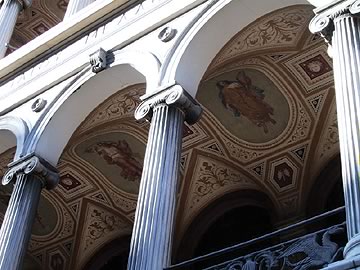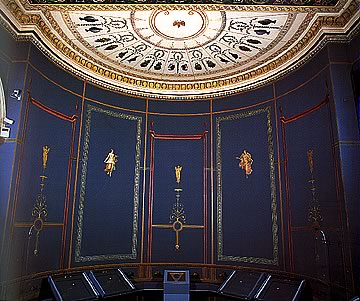
The Schliemann Mansion
Today the Numismatic Museum
Panepistimiou St, Athens, 1878-79
Architect
Ernst Ziller (1837-1923)
The Schliemann Mansion is one of the leading examples
of Athenian historicism, and one of Ernst Ziller’s most important
works. Ziller was the busiest architect in Athens between 1870 and the
late 1920s. This building, called Iliou Melathron ("House of Troy")
was built in 1878-79 by the famous German archaeologist Heinrich Schliemann,
discoverer of Troy, to be used as his residence.
The architectural composition is distinguished for its clarity in the
organisation of the plans and elegance in treating the façades.
The mansion is square on plan and is surrounded on three sides by a
garden; on its north side is the main entrance. The reception area is
on the upper ground floor, while the office, library and bedrooms are
on the upper floor, and the auxiliary areas on the lower ground floor.
The elevations are in the neo-Renaissance style, adapted to the spirit
of the Athenian classical tradition.
The façade has a tripartite treatment. In the centre there is
a two-storey arched loggia with marble Ionian columns. The end sections
are solid with marble balconies and arched openings on the ground floor,
with a pitched roof on the upper floor. The volume of the building is
articulated into a base of concave masonry corresponding to the basement,
a trunk that is the ground and upper floors, and the crown, the cornice
and parapet. There are terracotta statues on the crown of the building.
The interior is adorned by wall paintings in the Pompeii style by Yuri
Shubitz and excerpts from the texts of ancient Greek writers. The decorative
themes of the mosaic floors were an expression of its owner’s love
of Greek antiquity.
The mansion was built using the most sophisticated technology of the
time: a system of natural air conditioning through ducts, a central-heating
system that brought hot air through the floors of the rooms, and wooden
rolling shutters on the windows, unique at that time.
The building was owned by Schliemann’s wife Sophia until 1923.
It then passed into the public sector and housed first the Council of
State (1929-34), then the Supreme Court (1934-1980) and finally the
Appellate Court (1981-82). Today it houses the Numismatic Museum on
its first floor.
TRANSPORTATION


